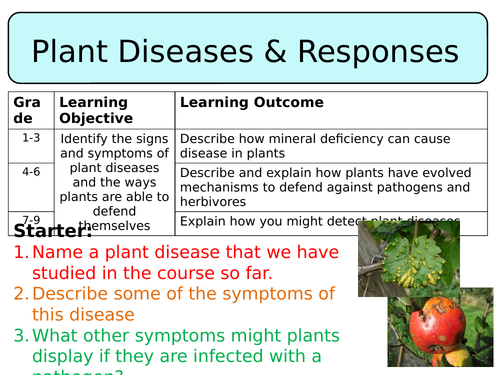
This lesson is designed for the NEW AQA Biology GCSE, particularly the 'Infection & Response' SoW for the higher tier.
For more lessons designed to meet specification points for the NEW AQA Trilogy specifications for Biology, Chemistry and Physics please see my shop: https://www.tes.com/teaching-resources/shop/SWiftScience
The first part of this lesson is a recap on the plant diseases students should have already covered within the 'infection & response' unit - rose black stop and tobacco mosaic virus. Plants will then be asked to come up with a brainstorm of the symptoms plants may exhibit when they are diseased. Once pupils have discussed this and tried to come up with some ideas you can reveal some of the common symptoms on the PowerPoint slide, along with images and examples.
The next slide looks at the ways in which plant diseases can be diagnosed, from gardening manuals to monoclonal antibody testing kits.
The next activity focuses on the role of certain minerals in the growth and development of plants, firstly students will draw a table in their book and then they will given a slip of information about one of the mineral ions - nitrates, magnesium or potassium. Pupils will need to walk around the room or swap these slips of paper with people on the same table as them to complete the table, they can then assess their work.
The final part of the lesson focuses on plant defence responses, firstly pupils will be shown some diagrams of plants and their defence methods and will be asked to think > pair > share the potential ways plants can defend against disease.
Pupils will then be given a card sort with different plant defence mechanisms, students need to sort these into three different categories - physical barrier, chemical barrier, defence against herbivore. Once completed pupils can then assess their work using the answers provided.
The final task is an exam-style question on what they have learnt that lesson, pupils of higher ability may want to complete these questions in silence at the backs of their book. Pupils can then self or peer-assess their work.
Plenary activity is to write 3 key words, 2 facts and 1 question about what pupils have learnt that lesson.
All resources are included at the end of the presentation. Thanks for looking, if you have any questions please let me know in the comments section and any feedback would be appreciated :)
For more lessons designed to meet specification points for the NEW AQA Trilogy specifications for Biology, Chemistry and Physics please see my shop: https://www.tes.com/teaching-resources/shop/SWiftScience
The first part of this lesson is a recap on the plant diseases students should have already covered within the 'infection & response' unit - rose black stop and tobacco mosaic virus. Plants will then be asked to come up with a brainstorm of the symptoms plants may exhibit when they are diseased. Once pupils have discussed this and tried to come up with some ideas you can reveal some of the common symptoms on the PowerPoint slide, along with images and examples.
The next slide looks at the ways in which plant diseases can be diagnosed, from gardening manuals to monoclonal antibody testing kits.
The next activity focuses on the role of certain minerals in the growth and development of plants, firstly students will draw a table in their book and then they will given a slip of information about one of the mineral ions - nitrates, magnesium or potassium. Pupils will need to walk around the room or swap these slips of paper with people on the same table as them to complete the table, they can then assess their work.
The final part of the lesson focuses on plant defence responses, firstly pupils will be shown some diagrams of plants and their defence methods and will be asked to think > pair > share the potential ways plants can defend against disease.
Pupils will then be given a card sort with different plant defence mechanisms, students need to sort these into three different categories - physical barrier, chemical barrier, defence against herbivore. Once completed pupils can then assess their work using the answers provided.
The final task is an exam-style question on what they have learnt that lesson, pupils of higher ability may want to complete these questions in silence at the backs of their book. Pupils can then self or peer-assess their work.
Plenary activity is to write 3 key words, 2 facts and 1 question about what pupils have learnt that lesson.
All resources are included at the end of the presentation. Thanks for looking, if you have any questions please let me know in the comments section and any feedback would be appreciated :)
Get this resource as part of a bundle and save up to 45%
A bundle is a package of resources grouped together to teach a particular topic, or a series of lessons, in one place.
Something went wrong, please try again later.
This is brilliant and much appreciated.
Lots of good activities, practise questions and information! Thank you very much
Excellent lesson, good afl, plenty of information, fun and engaging. No wonder most your resources are 5 star. Thank you
Report this resourceto let us know if it violates our terms and conditions.
Our customer service team will review your report and will be in touch.
£3.00
